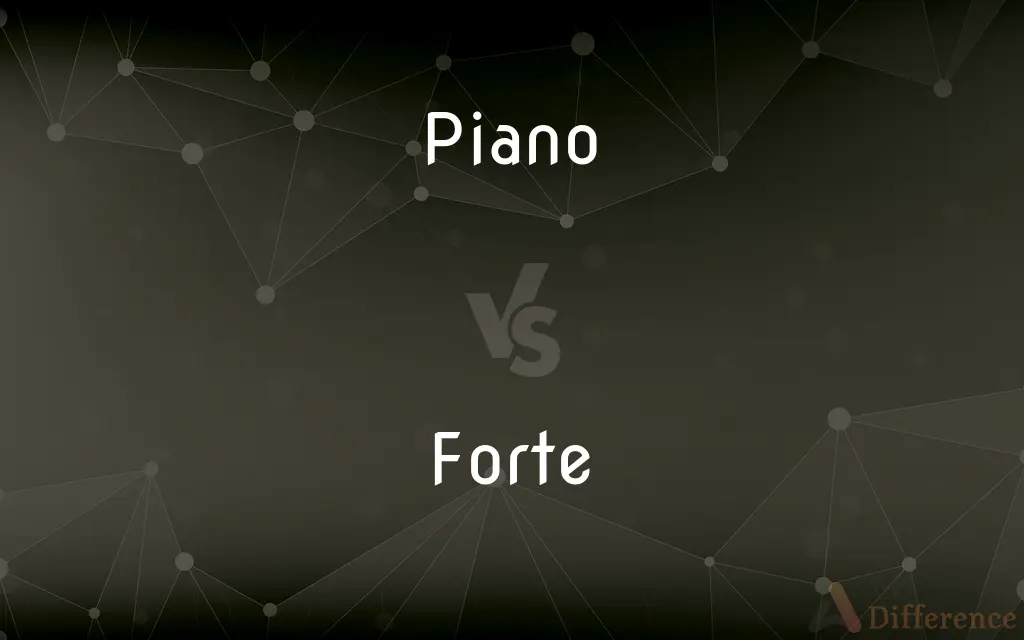Piano vs. Forte — What's the Difference?
By Tayyaba Rehman & Fiza Rafique — Updated on March 8, 2024
Piano signifies a soft or quiet sound level in music, while forte indicates a loud or strong sound.

Difference Between Piano and Forte
Table of Contents
ADVERTISEMENT
Key Differences
Piano in music notation instructs musicians to play softly, conveying a sense of intimacy, subtlety, or tranquility in the piece. This dynamic can add depth and emotion, allowing for nuanced expressions in the performance. On the other hand, forte directs players to perform loudly, bringing intensity, energy, and a robust presence to the music, often used to highlight climactic or emphatic moments.
The use of piano in a musical piece can create a contrast that emphasizes the more delicate or introspective passages, allowing for a wide range of emotional expression. Whereas, the implementation of forte can serve to punctuate and strengthen the dramatic elements of a composition, making certain sections stand out with vigor and power.
Composers often employ the dynamics of piano and forte to guide the emotional journey of a piece, using the interplay between soft and loud passages to build tension, release, and contrast. This dynamic range is crucial for achieving the desired expressive effect, whether in a solo performance or within an orchestral ensemble.
The transition from piano to forte (and vice versa) can be sudden, creating a stark contrast, or gradual, through crescendos and decrescendos, adding to the dynamic complexity of a composition. Such shifts not only enhance the musical texture but also engage the listener, drawing them deeper into the emotional landscape of the piece.
Understanding and mastering the nuances of piano and forte dynamics is essential for musicians, as it allows them to convey the intended emotional depth and complexity of a musical work. This mastery of dynamics contributes significantly to the overall impact and interpretative quality of a performance.
ADVERTISEMENT
Comparison Chart
Definition
A directive in music to play softly or quietly.
A directive in music to play loudly or strongly.
Emotional Impact
Conveys intimacy, subtlety, and tranquility.
Brings intensity, energy, and robust presence.
Role in Composition
Emphasizes delicate, introspective passages.
Highlights climactic, emphatic moments.
Contrast
Allows for nuanced expression and depth.
Strengthens dramatic elements and punctuates music.
Transition
Can shift to forte for impact or remain soft for consistency.
May transition to piano for contrast or maintain loudness for emphasis.
Compare with Definitions
Piano
Soft or quiet dynamic level in music.
The pianist played the nocturne with such a delicate piano touch, it felt like a whisper in the night.
Forte
Loud or strong dynamic level in music.
The orchestra's forte passage in the finale was powerful and filled the concert hall with sound.
Piano
Evokes a sense of calmness or introspection.
The gentle piano sections of the symphony brought a sense of peace to the audience.
Forte
Often used for climactic or emphatic parts of a piece.
The chorus entered with a forte declaration, capturing the audience's full attention.
Piano
Used to highlight more sensitive or emotional parts of a piece.
The composer marked the opening theme piano to emphasize its vulnerability.
Forte
Adds excitement, strength, or urgency.
The forte section of the march infused the performance with a sense of boldness and energy.
Piano
Requires control and precision from the musician.
Achieving a true piano sound on the trumpet demanded great skill and breath control.
Forte
Requires energy and sometimes physical strength from the musician.
Playing the timpani forte in the symphonic piece required both precision and force.
Piano
Offers a range within softness, from very soft (pp, pianissimo) to relatively soft (mp, mezzo-piano).
The transition from mezzo-piano to pianissimo in the piece required a subtle decrease in volume.
Forte
Has degrees of loudness, from loud (f, forte) to very loud (ff, fortissimo).
The fortissimo section demanded the musicians to play with maximum volume and intensity.
Piano
The piano is an acoustic, stringed musical instrument invented in Italy by Bartolomeo Cristofori around the year 1700 (the exact year is uncertain), in which the strings are struck by wooden hammers that are coated with a softer material (modern hammers are covered with dense wool felt; some early pianos used leather). It is played using a keyboard, which is a row of keys (small levers) that the performer presses down or strikes with the fingers and thumbs of both hands to cause the hammers to strike the strings.
Forte
Something in which a person excels
“His forte was in defusing negative rumors before they ever exploded into news accounts” (Jane Mayer).
Piano
A large keyboard musical instrument with a wooden case enclosing a soundboard and metal strings, which are struck by hammers when the keys are depressed. The strings' vibration is stopped by dampers when the keys are released and can be regulated for length and volume by two or three pedals.
Forte
The strong part of a sword blade, between the middle and the hilt.
Piano
A passage performed or marked to be performed softly.
Forte
A note, passage, or chord played forte.
Piano
(especially as a direction) soft or softly.
Forte
In a loud, forceful manner. Used chiefly as a direction.
Piano
(especially as a direction) soft or softly.
Forte
A strength or talent.
He writes respectably, but poetry is not his forte.
Piano
A musical instrument with a manual keyboard actuating hammers that strike wire strings, producing sounds that may be softened or sustained by means of pedals.
Forte
The strong part of a sword blade, close to the hilt.
Piano
A passage to be played softly or quietly.
Forte
A passage in music to be played loudly; a loud section of music.
This forte marks the climax of the second movement.
Piano
In a soft or quiet tone. Used chiefly as a direction.
Forte
(music) Loud. Used as a dynamic directive in sheet music in its abbreviated form, "f.", to indicate raising the volume of the music. (Abbreviated in musical notation with an f, the Unicode character 1D191.)
This passage is forte, then there's a diminuendo to mezzo piano.
Piano
(musical instruments) a percussive keyboard musical instrument, usually ranging over seven octaves, with white and black colored keys, played by pressing these keys, causing hammers to strike strings
The piano in his house takes up a lot of space.
She has been taking lessons for many years and now plays piano very well.
Forte
(music) Loudly.
The musicians played the passage forte.
Piano
To play the piano.
Forte
The strong point; that in which one excels.
The construction of a fable seems by no means the forte of our modern poetical writers.
Piano
(of or with fingers) To move (the fingers) up and down on, similar to the motions of a pianist playing the piano.
Forte
The stronger part of the blade of a sword; the part of half nearest the hilt; - opposed to foible.
Piano
To equip with a piano.
Forte
Loudly; strongly; powerfully.
Piano
To become softer and less intense.
Forte
An asset of special worth or utility;
Cooking is his forte
Piano
(music) softly, as a musical direction (abbreviated to p. in sheet music)
Forte
(music) with great loudness
Piano
(music) Soft, quiet.
Forte
The stronger part of a sword blade between the hilt and the foible
Piano
(in extended use) Gentle, soft, subdued.
Forte
Used chiefly as a direction or description in music;
The forte passages in the composition
Piano
Soft; - a direction to the performer to execute a certain passage softly, and with diminished volume of tone. (Abbrev. p.
Forte
Used as a direction in music; to be played relatively loudly
Piano
A well-known musical instrument somewhat resembling the harpsichord, and consisting of a series of wires of graduated length, thickness, and tension, struck by hammers moved by keys.
Piano
A stringed instrument that is played by depressing keys that cause hammers to strike tuned strings and produce sounds
Piano
(music) low loudness
Piano
Used chiefly as a direction or description in music;
The piano passages in the composition
Piano
Used as a direction in music; to be played relatively softly
Common Curiosities
How is forte used in musical compositions?
Forte is used to indicate a loud or strong dynamic level, often highlighting important or climactic sections of a piece.
What does piano mean in music?
Piano means to play softly or quietly in music, indicating a lower dynamic level.
How does a musician transition from piano to forte?
Transitions can be gradual, through a crescendo, or sudden, as indicated by the composer, depending on the desired effect.
What is the difference between piano and pianissimo?
Piano indicates soft playing, while pianissimo (pp) indicates even softer playing, representing a further decrease in dynamic level.
Is forte always the loudest dynamic in music?
Forte is loud, but fortissimo (ff) is even louder. Composers may specify a range of loud dynamics.
Does playing forte require more physical effort?
Often, yes. Playing forte can require more energy and physical strength, especially on certain instruments.
Are piano and forte dynamics relevant in all musical genres?
While mainly used in classical music, the concepts of piano and forte dynamics apply across many genres, influencing expression and emotion.
Can an entire piece be written at a piano dynamic level?
Yes, some compositions may maintain a piano dynamic throughout to create a specific atmosphere or mood.
What role do dynamics play in musical interpretation?
Dynamics are crucial for expressing the composer's intentions, adding contrast, and engaging the listener.
Can a piece of music have both piano and forte sections?
Yes, many compositions use a range of dynamics, including both piano and forte, to create contrast and emotional depth.
Can piano dynamics be emotional?
Yes, piano dynamics often convey a sense of intimacy, subtlety, or reflection, adding emotional depth to music.
Can the meaning of piano and forte vary between instruments?
While the basic meaning remains the same, the execution and impact can vary due to the unique timbral qualities of different instruments.
How do piano and forte contribute to the storytelling in music?
They help to underline narrative elements, emphasize emotions, and highlight moments of tension and release within a musical story.
How do ensembles coordinate piano and forte dynamics?
Through the conductor's guidance and individual musicians' attention to the score and each other, ensembles synchronize dynamic changes.
How does a composer decide when to use piano or forte?
Composers use piano and forte to shape the musical narrative, emotional impact, and structural highlights of a composition.
Share Your Discovery

Previous Comparison
Hanger vs. Hangar
Next Comparison
Vomit vs. HorkAuthor Spotlight
Written by
Tayyaba RehmanTayyaba Rehman is a distinguished writer, currently serving as a primary contributor to askdifference.com. As a researcher in semantics and etymology, Tayyaba's passion for the complexity of languages and their distinctions has found a perfect home on the platform. Tayyaba delves into the intricacies of language, distinguishing between commonly confused words and phrases, thereby providing clarity for readers worldwide.
Co-written by
Fiza RafiqueFiza Rafique is a skilled content writer at AskDifference.com, where she meticulously refines and enhances written pieces. Drawing from her vast editorial expertise, Fiza ensures clarity, accuracy, and precision in every article. Passionate about language, she continually seeks to elevate the quality of content for readers worldwide.














































